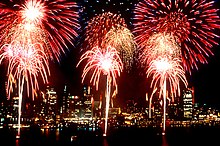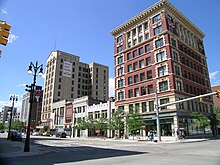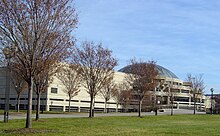Culture of Detroit
The culture of Detroit, Michigan, has influenced American and global culture through its commercial enterprises and various forms of popular music throughout the 20th and 21st century. Its automotive heritage plays an important role in the city's culture.
Entertainment and performing arts
Music has been the dominant feature of Detroit's
Throughout the
In the late 1960s, Metro Detroit was the epicenter for high-energy rock music with
.Birth to a new music culture beginning in the 2010s,
Fashion
The annual "Fash Bash," a major fashion event, typically held in the
Fashion designers that have enjoyed global success include Anna Sui who was born and raised in the city. The designer draws heavy inspiration from Detroit's music scene of the 1960s and 1970s including local bands such as the MC5.[8][9][10][11]
In 1991, a cultural phenomenon began among hair salons which evolved into the Detroit Hair Wars. Trendsetting salons, like Hair N Shears II, on The Avenue of Fashion, helped usher in this trend. A showcase of fantastical hairpiece creations, often using human hair as the main content, has since become a national trend among African-American hair-styling tours.[12]
Festivals and events


Detroit has three major events that are associated with the automobile industry: the
The
Hosted by the United Irish Societies, the Detroit St. Patrick's Parade is one of the largest St. Patrick's parades in North America and is held annually in Corktown.[17]
The day before
The
Two large
Events introduced in the 2010s include the Motown Winter Blast[21] in February and the Detroit River Days[22] in June .
Ethnic culture

Mexicantown had a 6.9 percent population rise to 96,000 from 1990 to 2000, the city's revitalized Mexicantown has improved the local economy. About half the residents are
The Detroit area's diverse population includes

The east necklace of downtown links
In 1959,
The Shrine of the Black Madonna of the Pan-African Orthodox Christian Church was founded in 1953 by the Rev. Albert B. Cleage. One of the churches' institutions is the Shrine of the Black Madonna Cultural Center & Bookstore, one of the nation's oldest black-owned bookstores.
The Graystone International Jazz Museum documents jazz in Detroit.[27][28]
Perhaps the most legendary is
Cultural and social clubs
-
The world's largest Masonic Temple, the Detroit Masonic Temple serves as home to a variety of fraternal and charitable organizations.
-
Over a century of Detroit business leaders have belonged to the Detroit Club founded in 1882.
-
Private sporting clubs include the Detroit Athletic Club, the Detroit Golf Club, and the Detroit Boat Club
-
Since 1934, business leaders have belonged to the Detroit Economic Club.
-
The Scarab Club is an artist's club, gallery, and studio.
-
The Players clubhouse and theatre.
Sister cities
Detroit has seven sister cities, as designated by Sister Cities International:[29]
 Toyota, Japan[30]
Toyota, Japan[30] Dubai, United Arab Emirates
Dubai, United Arab Emirates Turin, Italy[31]
Turin, Italy[31] Kitwe, Zambia
Kitwe, Zambia Minsk, Belarus
Minsk, Belarus Nassau, Bahamas
Nassau, Bahamas Chongqing, P.R. China
Chongqing, P.R. China
Detroit has a long and very close relationship with nearby ![]()
![]() Windsor, Ontario
Windsor, Ontario
See also
- Cinema Petit
- Detroit Historical Museum
- Detroit in literature
- List of films set in Detroit
- List of people from Detroit
- List of songs about Detroit
- Michigan History magazine
References
- ^ DTE Energy Music Theatre Listed as 2004 Top Attended Amphitheatre (1/25/05 Archived December 23, 2005, at the Wayback Machine. DTE Energy Music Theatre.
- ^ Herb Boyd (9/17/97) Cookin' in the Motor City. The Metro Times.
- ISBN 0-634-02861-8., p. 251.
- ISBN 0-87930-653-X.
- ISBN 0-87930-759-5.
- ISBN 0-937247-34-0.
- ^ Hodges, Michael H. (September 8, 2003).Fox Theater's rebirth ushered in city's renewal Archived December 5, 2012, at archive.today. Michigan History, The Detroit News
- ^ "General Motors and Fashion Industry Target Breast Cancer Through Concept:Cure" (Press release). General Motors Corporation. PRNewswire.com. October 21, 1997. Retrieved October 28, 2015.
- ^ Eels, Josh (April 5, 2012). "Jack Outside the Box: Jack White Is the Coolest, Weirdest, Savviest Rock Star of Our Time". The New York Times. Retrieved March 23, 2016.
- ^ McGonigal, Mike (March 23, 2016). "How Third Man's giant Detroit location is becoming the ultimate D.I.Y. ecosystem". metrotimes.com. Detroit Metro Times. Retrieved March 23, 2016.
- ^ Boyd, Kayla (November 10, 2015). "Anna Sui talks fashion, success at Michigan Theater". EasternEcho.com. Retrieved January 27, 2016.
- ^ Sarah Klein (April 7, 2004). "Tressed to kill". Metrotimes. Retrieved September 25, 2006.
- ^ "The Dirty Show". The Dirty Show. Retrieved December 27, 2013.
- ^ "DAMNED Exhibition". thatdamnedshow.com.
- ^ "Noel Night". Detroitmidtown.com. Archived from the original on October 31, 2013. Retrieved December 27, 2013.
- ^ Everyone Loves a Parade Archived June 3, 2006, at the Wayback Machine. The Parade Company.
- ^ Baetens, Baetens (March 6, 2019). "Corktown's St. Patrick's Parade celebrates Detroit's Irish heritage". The Detroit News. Retrieved March 7, 2019.
- ^ Robert Strybel (2/5/01). Polish fast food in America?. polartcenter.com.
- ^ "LGBT supporters pack Hart Plaza for biggest Motor City Pride in history". The South End. June 9, 2011. Retrieved June 7, 2013.
- ^ Collins, Andrew. "Hotter Than July 2013 – Detroit Black Gay Pride 2013". About.com. Archived from the original on December 11, 2013. Retrieved December 6, 2013.
- ^ "Motown Winter Blast". Winterblast.com. Retrieved January 15, 2014.
- ^ "Detroit River Days". Detroit River Days. Archived from the original on February 18, 2015. Retrieved December 27, 2013.
- ^ "see neighborhoods". Cityscape Detroit. Archived from the original on December 15, 2013. Retrieved December 27, 2013.
- ^ a b Williams, Corey (February 28, 2008).New Latino Wave Helps Revitalize Detroit. USA Today. Retrieved December 12, 2010.
- ^ Baulch, Vivian M. (September 4, 1999). Michigan's greatest treasure – Its people Archived July 31, 2007, at archive.today. Michigan History, The Detroit News. Retrieved December 12, 2010.
- ^ Harmonie Park District Archived May 9, 2015, at the Wayback Machine.Retrieved on August 23, 2009.
- ^ The Graystone International Jazz Museum Archived September 11, 2009, at the Wayback Machine
- ^ Swinging Through Time: The Graystone Museum and the story of Detroit jazz Archived May 1, 2008, at the Wayback Machine
- ^ "Sister Cities Program | City of Detroit". www.detroitmi.gov. Archived from the original on June 29, 2010. Retrieved July 1, 2010.
- ^ "International Sister Cities". City.toyota.aichi.jp. Archived from the original on January 17, 2010. Retrieved July 1, 2010.
- ^ "Città di Torino – Relazioni Internazionali". Comune.torino.it. April 7, 1998. Archived from the original on May 27, 2010. Retrieved July 1, 2010.









